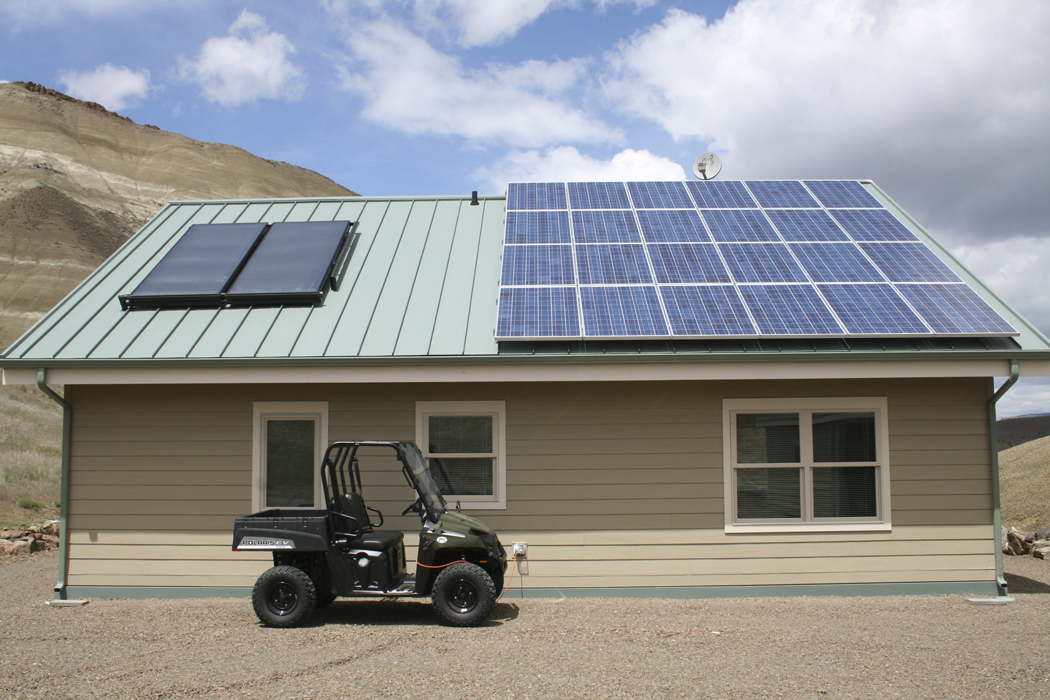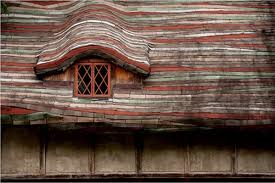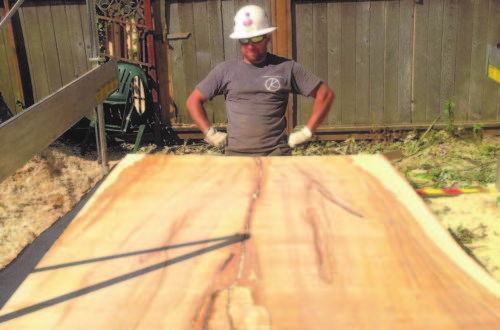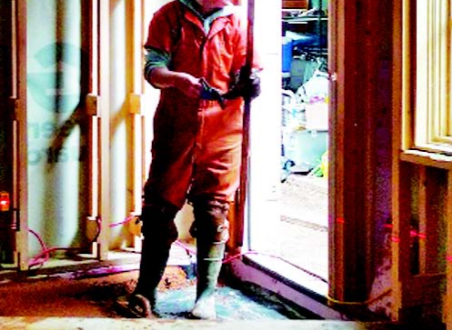The Park Management Team at John Day Fossil Beds National Monument successfully pursued building an unconventional, state-of-the-art zero-energy home as a replacement for the ranger residence at the remote Painted Hills Unit The goal, which is to make the park’s Painted Hills Unit carbon neutral and energy self sufficient in housing, administration and transportation, was close to being realized with the completion of the new residence. This house, built at a cost comparable to standard construction, not only eliminates utility costs to the ranger in residence, but it also exposed local contractors and the public to a building method far more energy efficient than anything they were familiar with. The house is so efficient, in fact, that it generates far more energy than it uses, all of which is carbon free.

The original residence had reached the end of its useful life. It was costly to maintain, did not have a foundation, was built on expansive soils, and was not energy efficient. The park management team decided to pursue building an unconventional, state-of-the-art zero-energy home as a replacement for the house. They researched the possibilities thoroughly, developed a plan, and submitted a well developed project proposal for funding to the Pacific West Region. The plan included building a house that would not only produce more energy than it would use, but would also be focused on the conservation/efficiency side in order to treduce energy needs. An additional goal was that the house would cost no more than a house built using the standard housing designs in the NPS housing program. Because this project involved building nonstandard housing, approval was problematic. However, the Pacific West Region supported the project after the park presented its potential advantages at a regional project review.
The house is a 1200-square-foot structure constructed on a heavily insulated concrete slab. It utilizes structural insulated panels (SIPs) for both walls and roof to provide a very air tight building envelope with extremely low heat transfer. SIP construction eliminates thermal bridging in the exterior walls caused by the wall studs used in standard construction. Because the SIP panels are manufactured to order with all window and door openings pre-cut, there is very little construction waste.. Besides the SIP construction, the house incorporates several other innovative energy-saving measures including:
1) A heat recovery ventilation (HRV) system that uses exhaust air to heat or cool incoming fresh air to avoid losing energy while providing a constant supply of fresh air. This HRV can also be used as an economizer, utilizing temperature differences to capture and store heat or cool air in the early morning or late afternoon, depending upon ambient air temperatures.
2) Better than Energy Star appliances throughout the house.
3) A mini-split, high efficiency heat pump to provide what little heating and cooling that is required.
4) Triple glazed, argon gas-filled windows
5) Double- and triple-sealed doors to eliminate air leakage.
6) A grid-tied photovoltaic system and drain-down solar hot water panels on a south-facing roof, optimally angled for solar gain
The constructed house has a home energy rating (HERS) of -43. This compares to a rating of +100 for an average home constructed to code today, and a rating of +80 for an Energy Star-rated home constructed in central Oregon. This extraordinary HERS rating means that the home will actually generate 43% more energy than it will consume. The house also will achieve an Emerald Rating from the National Association of Home Builders through its National Green Building Standards program. This rating is the highest standard of the rating system. Very few homes can qualify at this level.
But the house was only the beginning. To establish a carbon-neutral operation, the transportation requirements also needed to be factored in. Polaris stepped up to address this need and loaned the monument an electric vehicle. Says Jim Hammett, the park’s superintendent “We’ll be able to plug it in at the house and use the surplus solar-based energy it generates to charge it,” he said.
Additionally, through an agreement with Bonneville Power Administration (BPA), the energy purchased by the monument from BPA is produced using only renewable, carbon-neutral sources.
The techniques and materials used to construct this residence are directly reproducible and can be used in any national park, wildlife refuge, national forest or other federal agency to construct housing. Similarly, the use of SIPS, HRVs, mini-split heat pumps, are directly applicable to any facility construction anywhere. Finally, exposing the public to this type of construction furthers its adoption as a new standard for construction and could go very far in reducing carbon emissions associated with residential energy consumption.
Editor’s note: For the past five years we have spent the last week end of July in John Day at the SolWest Fair. Jennifer Barker and her crew put on such a special event that the trip is always worth it. This year we were especially impressed with the National Park Service’s (NPS) booth display featuring their new residence and electric vehicle.
In a conversation with Jim Hammett we were also impressed with his dedication and drive to push the envelope of change that can be wrought even in a federal agency. Sound research and creative thinking enabled Jim to put together a house design that not only exceeded everyone’s conservation goals, but did that at no extra cost over normal construction. But Jim isn’t stopping here. He and his team are ever on the search for ways to reduce energy consumption and are now planning to replace the halogen lights in the Thomas Condon Paleontology Center’s gallery with LED lights. He is also working on ways to spark employee energy awareness and savings.







2 Comments
Ray Shives
Hello,
I have been interested in the net zero ranger residence at the John Day Fossil Beds National Monument. The park service claims to not know of its existence. I have graduated the Renewable Energies Technologies (RET) program at Clackamas Community College. I had wanted some data on production, usage, efficiencies, structure, and sizing. I was not able to obtain any information directly; possibly you have the data or can access it. Even a set of blueprints would have most of the data needed to extrapolate the rest. Would you be able to assist in obtaining this information? Thank you.
Ray.
Susan Place
Hello Ray
Thank you for your inquiry about the Ranger’s home in the John Day Fossil Beds.
Here is a link to the original article:
https://www.nps.gov/joda/learn/news/painted-hills-green-house.htm
There are several leads in the article that you can chase for additional information.
Hope this helps.
Cheers,
Gary